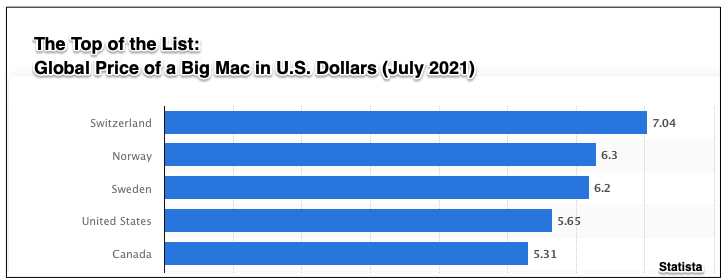Thinking of prices in different countries, we can look at the Big Mac Index. Though not a comparative gauge of inflation from one country to another, it does tell us what we would spend on a global McDonald’s sampling tour.
Although current prices have changed since our July 2021 graphs (below), the more and less expensive places remain approximately the same. In the Big Mac Index for 2022, still Switzerland and Norway have the most pricey Big Macs. Meanwhile, Russia, and Turkey are now at the bottom:

From our Big Mac world tour, next, we can get a taste of global inflation.
Global Inflation
Comparing inflation rates between the third quarter of 2019 and 2021, Pew Research cited 39 countries with higher rates. However, among the 46 countries they looked at, inflation was up the most in Brazil, Turkey, and the U.S. With less inflation, Japan and the Netherlands were the developed nations at the bottom of their list.
You can see that Pew Research (like the above Big Mac Index) also used data from the summer of 2021:

Our Bottom Line: Current Causes of Inflation
Many economics books would tell you that we can have demand pull, cost push, or a single cause of inflation. Demand pull refers to too many dollars chasing too few goods while cost push focuses on land, labor, and /or capital rising in price. Meanwhile, the singular cause is one commodity going up in price and then rippling through the economy…like oil. More precisely, for demand, we can cite the “mismatch” between what factories have produced and what pandemic stricken consumers want. Correspondingly, on the cost side, the tangles in global supply chains have nudged production costs up. And then, to all of that we can add the chips shortage and ascending oil prices. At the same time, outside the U.S., sub-Saharan Africa has had to cope with the impact of higher energy prices on the cost of fertilizer. Similarly, The Washington Post explained that in Europe, rising energy prices are fueling inflation. In addition, a European Parliament report, cites the same phenomena that we are seeing in the U.S.– the supply snarls and skewed consumer spending.
I guess we can conclude by saying the U.S. is not alone. From Trading Economics, these are the most recent inflation rates:

My sources and more: The Washington Post and Pew Research are a good starting point for a description of the world’s inflation. Then, this European Parliament Report provided more insight while The Economist Big Mac Index gave us a different twist.







